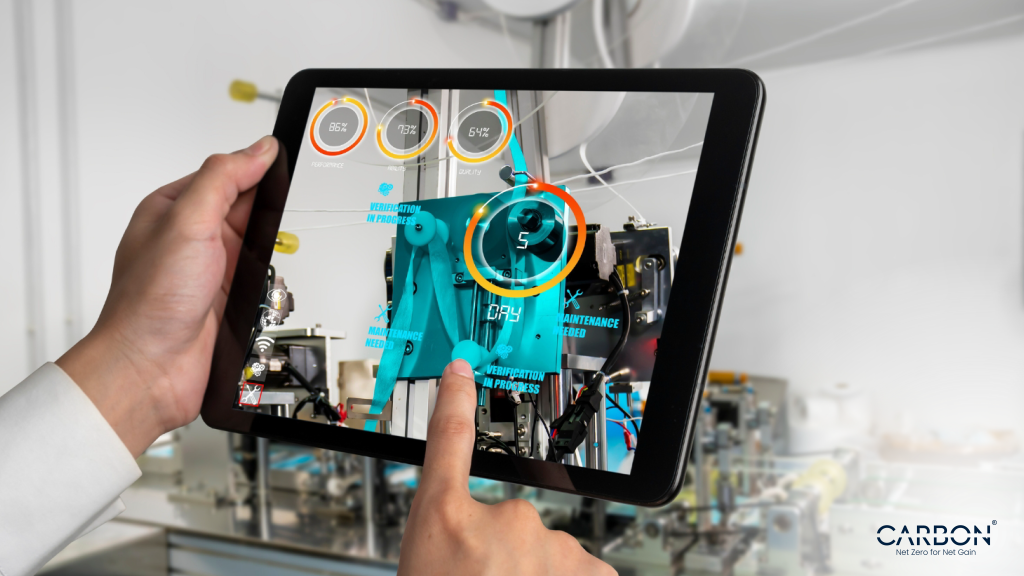Key Takeaways
- Equipment failures spike carbon emissions
- Predictive maintenance prevents inefficiencies before they grow
- AI enables real-time, intelligent intervention
- Lower downtime = lower emissions and costs
- Longer equipment life reduces Scope 3 impact
- Predictive systems are a sustainability force multiplier
- Most companies resist due to bias, not logic
- POB turns maintenance into a structured ESG driver
- Early adopters will define the next decade of efficiency
Did you know that every time a machine breaks down, your carbon footprint spikes?
It’s not just an operational headache. It’s a sustainability disaster hiding in plain sight.
Faulty equipment sucks up more energy, drags down efficiency, and forces you to churn out replacement parts that never should have been needed in the first place.
And the biggest issue? All of this adds up to more emissions than most companies ever bother to count.
But it doesn’t have to be that way.
AI-powered predictive maintenance cuts costs and avoids downtime. It’s a sustainability superpower—one that extends machine lifetimes, slashes emissions, and ensures compliance all at once.
It’s not a tool, but a system. And the companies that master it are the ones who will dominate the future.
This article breaks down why predictive maintenance is a game-changer for sustainability and how companies can leverage it using a structured model. One that we call the Predictive Optimization Blueprint (POB).
Because while everyone else is still fumbling with patchwork solutions, you can be running a system that makes carbon reduction automatic.
The Carbon Cost Of Ignoring Predictive Maintenance
Here’s what most companies miss: Every time a machine breaks down, your carbon footprint goes up.
It’s not just about the energy lost during downtime. It’s about the inefficiencies that pile up over time.
The faulty pumps drawing more power than they should. The overheated engines burning through energy like a firehose. The motors that keep chugging along at half efficiency because no one’s paying attention.
Every one of these failures is a carbon emitter. And when you ignore them? They add up to a sustainability nightmare.
How Predictive Maintenance Works
At its core, AI-powered predictive maintenance is about prevention, not reaction. It’s about using real-time data, machine learning, and predictive analytics to identify issues before they cause inefficiencies or outright failures.
Here’s how the process breaks down:
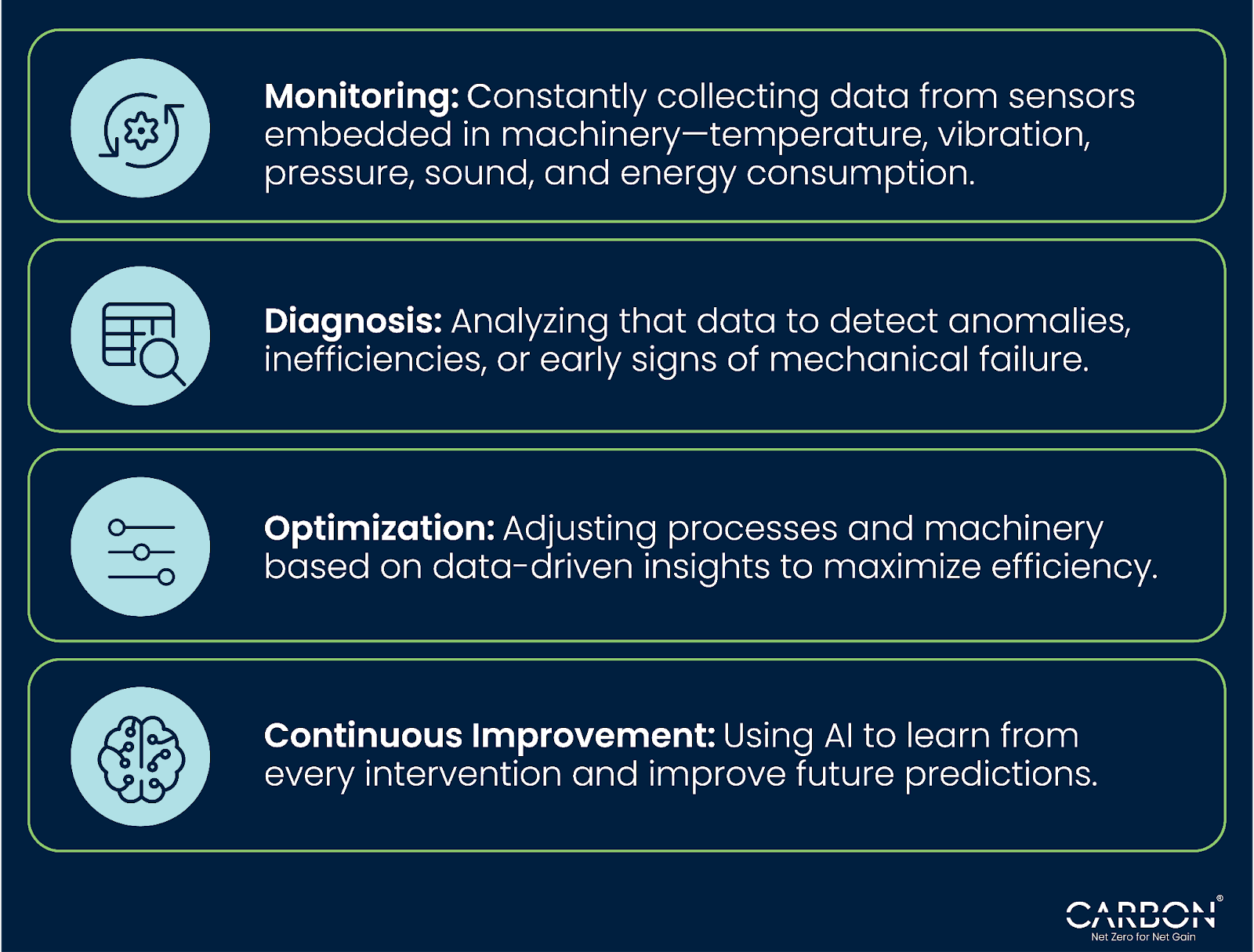
When done right, predictive maintenance does more than just prevent downtime. It creates a supply chain that’s leaner, cleaner, and smarter.
The Sustainability Impact: Why Predictive Maintenance Matters
If you think, predictive maintenance is just about avoiding equipment failure, you’re mistaken. It’s about reducing your carbon footprint by attacking inefficiencies at their source.
1. Energy Efficiency in Manufacturing
When machines run below optimal efficiency, they suck up more energy than they should. And wasted energy? It’s wasted money and wasted carbon.
By catching inefficiencies before they become failures, predictive maintenance keeps systems running as efficiently as possible. And that has a direct impact on your carbon footprint.
Example: In a manufacturing plant, predictive maintenance systems can detect a compressor running at 70% efficiency due to a worn-out valve. By replacing the valve before it failed, the plant can cut its energy consumption, saving hundreds of tons of CO₂ emissions per year.
2. Prolonged Equipment Lifetimes
Every time a machine needs to be replaced, your carbon footprint spikes. Manufacturing new machinery is energy-intensive, especially in industries like steel, cement, and chemicals.
Predictive maintenance extends machinery lifetimes by identifying and resolving inefficiencies before they cause catastrophic damage.
The longer your equipment lasts, the less often you need to manufacture or replace parts, cutting your Scope 3 emissions.
Example: A cement manufacturer applied predictive maintenance to its kiln operations, identifying early signs of overheating. Preventative adjustments can extend the kiln’s operational lifespan, reducing the need for energy-intensive replacements.
3. Avoiding Operational Disruptions
When equipment fails unexpectedly, operations grind to a halt. And downtime? It’s not just lost productivity. It’s a carbon drain.
Idle machinery continues to consume energy, sometimes at surprisingly high levels. Worse, restarting complex systems often requires energy spikes that drive emissions even higher.
Predictive maintenance reduces unplanned downtime, making your entire operation run smoother and cleaner.
Example: A food and beverage company can implement predictive maintenance across its refrigeration systems. By catching small inefficiencies before they spiraled into breakdowns, the company could reduce its downtime drastically and cut energy waste.
Behavioral Science Insights: Why Companies Resist Predictive Maintenance
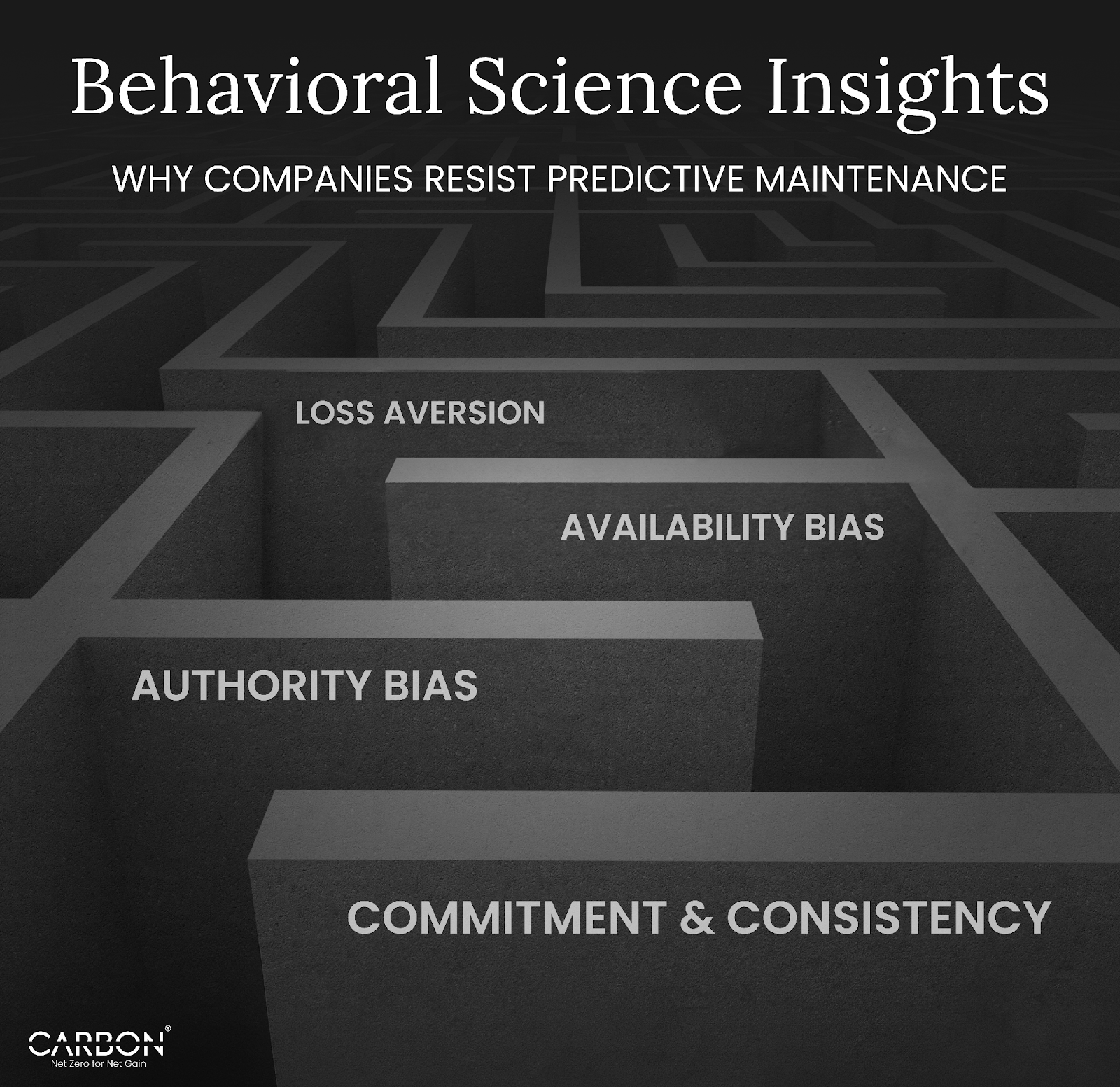
You’d think the benefits would be obvious. But companies still drag their feet when it comes to adopting predictive maintenance in manufacturing.
And the reasons are often psychological, not practical.
- Loss Aversion: Companies focus on the upfront costs of implementing predictive maintenance instead of the long-term savings. The pain of investing now feels worse than the potential benefits of efficiency gains later.
- Availability Bias: Executives tend to focus on visible, headline-grabbing sustainability measures like renewables while ignoring less glamorous but equally impactful solutions like predictive maintenance.
- Authority Bias: Companies often wait for industry leaders to adopt new systems before committing themselves. It’s safer to follow than to lead.
- Commitment & Consistency: Once a company has invested in a certain maintenance model, it’s hard to justify changing course—even when predictive maintenance offers better results.
The irony? The companies that resist predictive maintenance are the ones that need it most.
How Predictive Maintenance Reduces Carbon Emissions
When companies overlook predictive maintenance, they’re leaving massive sustainability gains on the table.
It’s not just about money. It’s about credibility.
Because the truth is the companies that master predictive maintenance will have a major advantage in meeting their ESG targets, satisfying investor expectations, and outperforming their competitors.
And the ones who ignore it? They’ll be left explaining why their efficiency numbers never seem to improve.
The carbon cost of ignoring predictive maintenance is real. And it’s getting higher every day.
Framework For Optimizing Energy Use With Predictive Maintenance
It’s one thing to know that predictive maintenance can cut your carbon footprint. It’s another to make it happen.
The difference? Having a system that ties everything together.
And that’s where the Predictive Optimization Blueprint (POB) comes in.
This framework will do more than prevent breakdowns, helping you build a maintenance system that reduces emissions, increases efficiency, and improves ESG performance—all at the same time.
Here’s how it works.
The Five Phases of the Predictive Optimization Blueprint (POB)
Most companies treat predictive maintenance as a patchwork solution, something you add to your operation when problems become too big to ignore.
But the companies that excel are the ones that treat it as a system.
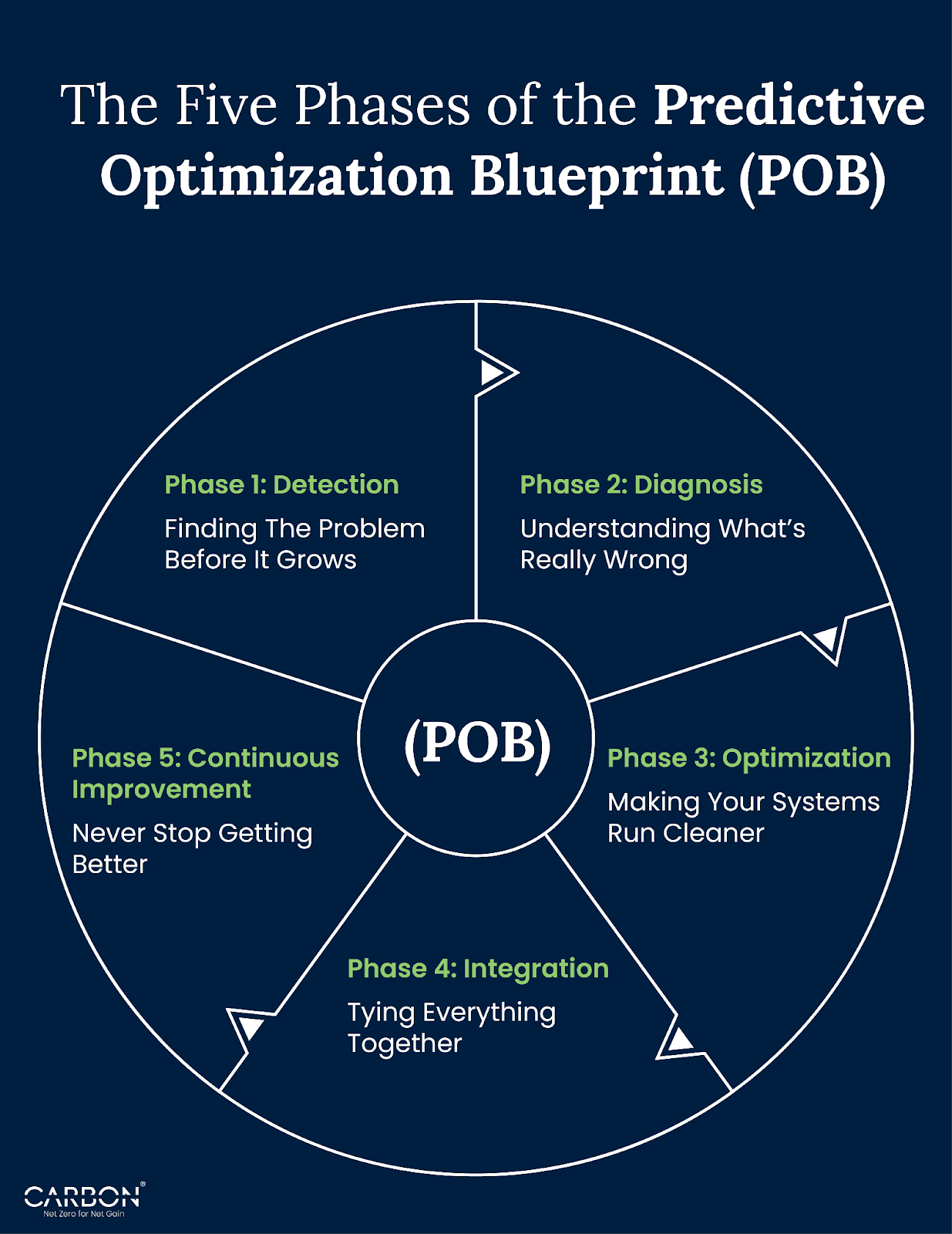
The Predictive Optimization Blueprint (POB) breaks down predictive maintenance into five distinct phases:
Phase 1: Detection – Finding The Problem Before It Grows
The first step in the POB framework is real-time monitoring. It’s about gathering data and making sure that data is actionable.
Using AI-driven sensors and predictive analytics, companies can continuously monitor machinery for signs of inefficiency or impending failure. Everything from temperature and pressure to vibration and energy consumption is tracked in real-time.
But here’s the key: Detection is only valuable if it’s accurate.
If your system sends false alarms or misses critical warnings, you’re not reducing emissions, you’re just adding noise. That’s why the POB framework emphasizes the importance of high-quality data and intelligent monitoring systems.
Example: A steel manufacturer can implement predictive analytics to monitor its blast furnaces. By catching heat loss anomalies before they escalate, the company can reduce energy waste annually.
Phase 2: Diagnosis – Understanding What’s Really Wrong
Once a problem is detected, the next step is diagnosis. And this is where many companies stumble.
Too often, companies rely on outdated diagnostic tools that provide incomplete or misleading information. The result? Fixing symptoms instead of solving the underlying problem.
The POB framework uses advanced analytics to determine the root causes of inefficiencies. Instead of just identifying that something’s wrong, it tells you exactly what’s wrong and why.
Example: A chemicals company might use predictive maintenance to diagnose inefficiencies in its cooling systems. By pinpointing the specific components causing excessive energy consumption, it can cut annual emissions significantly.
Phase 3: Optimization – Making Your Systems Run Cleaner
Once you know what’s wrong, the next step is fixing it. But here’s the difference: Optimization doesn’t mean repairing broken parts. It’s about making sure your entire system runs as efficiently as possible.
The POB framework focuses on continuous optimization. That means using data-driven insights to adjust processes, improve machinery performance, and eliminate inefficiencies wherever possible.
And the best part? It’s not a one-time fix. It’s an ongoing process that gets better the longer you use it.
Example: A cement manufacturer can use predictive analytics to optimize its kiln operations. By continuously adjusting temperature and airflow settings, it can reduce energy consumption over the course of a year.
Phase 4: Integration – Tying Everything Together
Here’s where most companies fail. They implement predictive maintenance systems, see some improvements, and then leave them running on autopilot.
But real carbon savings come from integration.
The POB framework emphasizes connecting predictive maintenance data with your broader carbon accounting systems. When your maintenance efforts are integrated with your ESG reporting, you can track your progress in real-time and make adjustments before problems escalate.
It’s not about fixing what’s broken. It’s about making sure every piece of your operation is aligned with your sustainability goals.
Example: A food and beverage company might integrate its predictive maintenance data with its carbon accounting platform. The result? A reduction in carbon emissions across its refrigeration systems.
Phase 5: Continuous Improvement – Never Stop Getting Better
The companies that win are the ones who never stop improving.
Predictive maintenance isn’t a one-and-done fix. It’s a continuous feedback loop that uses AI-driven analytics to identify new opportunities for efficiency and emissions reduction.
Every time you detect a problem, diagnose it, optimize it, and integrate the data—you’re making your entire operation more resilient. And the longer you use the POB framework, the better it gets.
Example: A petrochemicals firm can use predictive analytics to continuously refine its distillation processes. Over five years, it cut energy consumption and reduced Scope 3 emissions simultaneously.
The Industries That Stand To Gain The Most
Predictive maintenance isn’t just a nice-to-have. For some industries, it’s a survival tool.
The companies that gain the most from AI-powered predictive maintenance are the ones where equipment efficiency and uptime are directly tied to profitability and sustainability.
And the list is longer than you think.
Manufacturing
Every manufacturing process relies on complex machinery operating at peak efficiency. When something breaks down, the costs go beyond repair bills. They hit productivity, energy use, and emissions.
Why Predictive Maintenance Matters:
- Energy Efficiency in Manufacturing: Machinery running below optimal efficiency consumes more energy. Predictive maintenance ensures systems are always running at their most efficient.
- Carbon Reduction: By identifying inefficiencies before they escalate, manufacturers can cut emissions without sacrificing productivity.
- Prolonged Lifespans: Extending the life of machinery means fewer replacements—translating to reduced Scope 3 emissions.
Cement & Steel
Few industries are more energy-intensive than cement and steel. With processes that generate enormous amounts of heat and rely on continuous operation, every inefficiency adds up fast.
Why Predictive Maintenance Matters:
- Temperature Control: Kilns, blast furnaces, and cooling systems must maintain precise temperatures. Predictive maintenance helps prevent energy waste by optimizing thermal performance.
- Reduced Downtime: Unexpected failures can cause massive operational disruptions. Predictive maintenance reduces downtime, keeping emissions under control.
- Emission Reduction: Catching inefficiencies before they escalate means fewer CO₂ spikes from sudden malfunctions.
Chemicals & Petrochemicals
Chemical processing is complex, energy-hungry, and high-risk. And when systems fail, the carbon costs are enormous.
Why Predictive Maintenance Matters:
- Continuous Monitoring: AI-driven systems track performance metrics in real-time, preventing inefficiencies before they escalate.
- Optimization: Predictive analytics can refine distillation processes, cracking systems, and other high-heat operations for maximum efficiency.
- Safety & Compliance: Improved reliability reduces the risk of environmental incidents, enhancing ESG performance.
Food & Beverage
When refrigeration systems fail, it’s more than a productivity hit. It’s a carbon sinkhole. And for the food and beverage industry, where energy-intensive refrigeration is unavoidable, inefficiencies can be a major liability.
Why Predictive Maintenance Matters:
- Energy Efficiency in Manufacturing: Continuous monitoring ensures refrigeration systems run at peak efficiency.
- Waste Reduction: Predictive maintenance prevents spoilage by minimizing unexpected breakdowns.
- Cost Savings: Reduced energy use means lower bills and fewer emissions.
Future Trends & Predictive Analysis
The industries benefiting from predictive maintenance today are just the beginning. As AI-driven systems become more advanced, the opportunities for carbon reduction and efficiency gains will only expand.
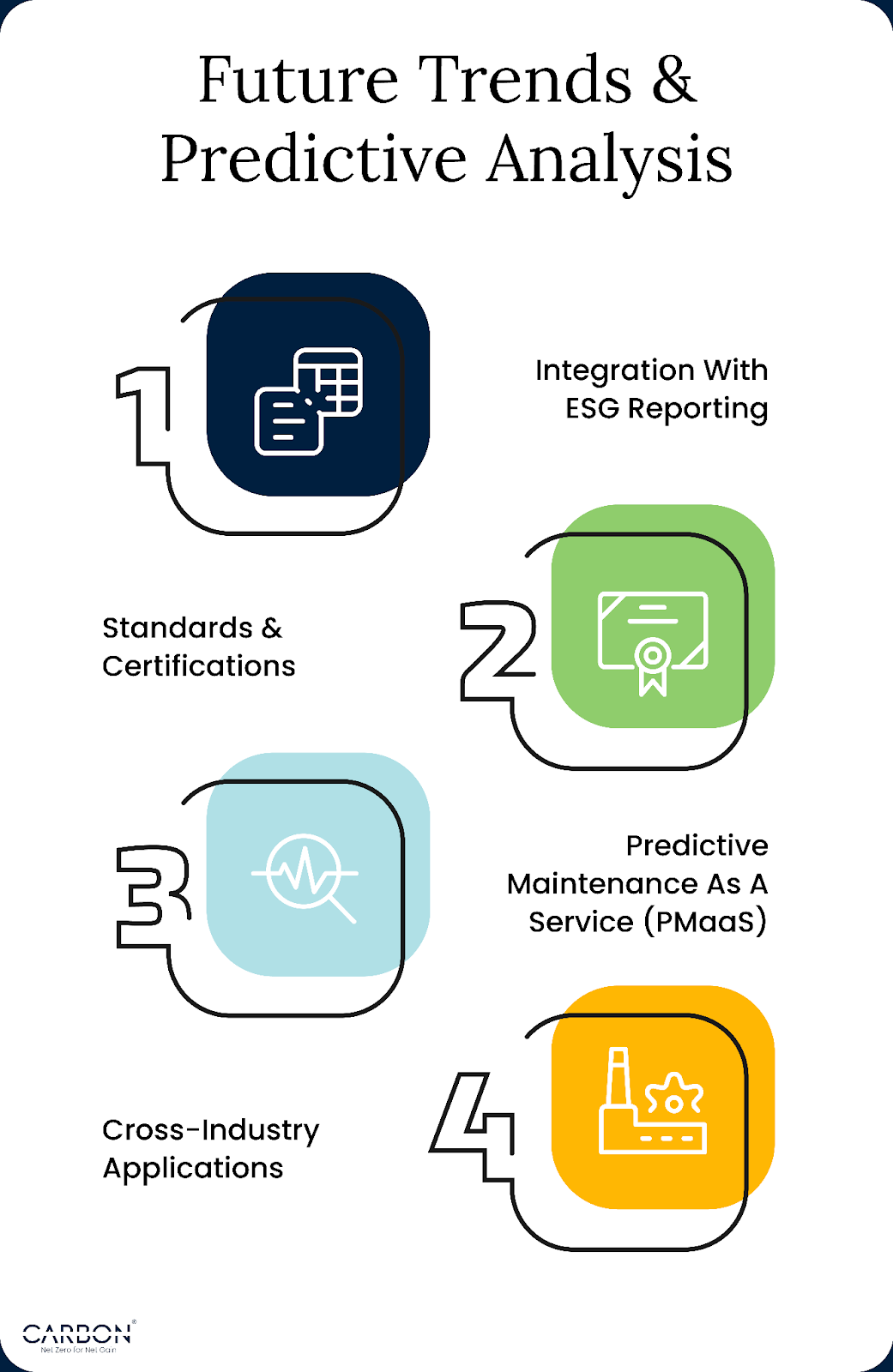
Here’s what to expect:
- Integration With ESG Reporting: As predictive maintenance systems generate more accurate data, companies will be able to tie efficiency gains directly to their ESG metrics.
- Standards & Certifications: Expect industry bodies to establish new standards for predictive maintenance, making it a compliance requirement rather than a competitive advantage.
- Predictive Maintenance As A Service (PMaaS): Companies offering predictive maintenance solutions on a subscription basis, making advanced systems accessible to smaller players.
- Cross-Industry Applications: As predictive maintenance proves its worth, expect industries outside of manufacturing and heavy industry—such as logistics, healthcare, and retail—to adopt similar strategies.
Why Early Adopters Will Win
The companies that get ahead of the curve won’t just cut emissions. They’ll build more resilient, efficient, and profitable operations.
And as regulations tighten and consumer expectations evolve, predictive maintenance will become a standard requirement, not a luxury.
The ones who adopt it early will set the standard. Everyone else will be playing catch-up.
Your Carbon Footprint Won’t Reduce Itself
Ignoring predictive maintenance is like ignoring a slow leak in a dam. You might not see the damage right away, but eventually? It all breaks down.
You can’t afford to keep running outdated systems and pretending the inefficiencies don’t exist. Not when every failure, every breakdown, every moment of downtime is adding to your carbon footprint.
AI-powered predictive maintenance is more than a cost-saving tool. It’s a sustainability multiplier.
It’s how you catch inefficiencies before they spiral into emissions. It’s how you turn raw data into carbon savings.
And it’s how you prove to investors, regulators, and consumers that your commitment to ESG performance isn’t just talk.
The companies that figure this out now are the ones who will lead the industry. The rest will be scrambling to catch up when predictive maintenance becomes the standard instead of the exception.
The truth is simple: Your carbon footprint won’t reduce itself.
But with the right framework? It doesn’t have to be complicated.
You already have the data. You already have the systems. All you need is a process that ties it all together.
And once you have that? Reducing emissions becomes second nature.
Because the longer you wait, the harder it gets.
Know more at https://carbonminus.com/contact-us/
FAQs
Q: What’s the carbon link to predictive maintenance?
Every inefficiency—overheating, friction, vibration—consumes excess energy. Predictive maintenance eliminates those waste points, reducing Scope 1 and Scope 3 emissions.
Q: Does this only apply to heavy industries?
No. Any operation with high energy use or essential equipment—food, pharma, logistics—benefits from predictive maintenance.
Q: What’s the ROI for predictive maintenance?
Most companies see ROI within 12–24 months, especially in energy-intensive sectors. Bonus: the carbon savings pay long-term ESG dividends.
Q: Can it plug into our current ESG platform?
Yes. CarbonMinus integrates predictive data directly into your reporting stack—turning efficiency into verifiable ESG progress.
Q: What if we don’t have the sensors or AI setup yet?
CarbonMinus can help you layer predictive systems over existing infrastructure—no need to rebuild from scratch.

